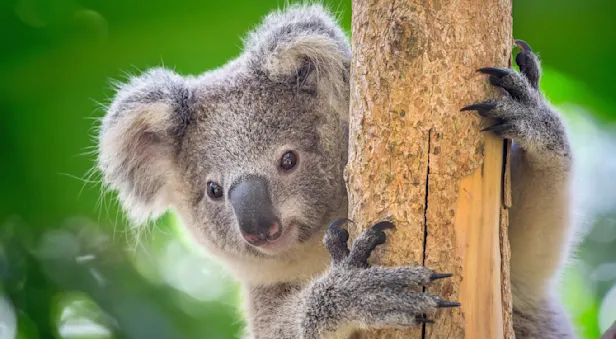
Know Before You Go


Wombat Facts | Australia South Wildlife Guide
Weighing up to 80 pounds, the wombat is the world’s largest burrowing animal and the second-largest marsupial after some species of kangaroo. With long, thick claws, these expert diggers create interconnecting tunnels that can be 100 feet long and 11.5 feet deep, constructed with designated sleeping chambers and several entrances and exits. During bushfires, the tunnels stay cool, offering wombats and other species, such as wallabies, rabbits, foxes and lizards protection from the flames. Unlike other marsupials, wombats have a rear-facing pouch, which protects joeys from getting sprayed with dirt.
Wombats live in the woodlands, coastlands, mountain forests and shrublands of southeast Australia. During the night, they use their rodent-like teeth and strong jaws to graze a variety of grasses, herbs, roots, bark and mosses—even obtaining their water intake from the vegetation.
There are three species of wombats: The common wombat, the southern hairy-nosed wombat, and the northern hairy-nosed wombat. Between 1926 and 1965, approximately 63,000 wombat skins were redeemed for cash in accordance with the Australian government‘s attempt to cull a “nuisance species.” Today, the southern hairy-nosed wombat is threatened and the northern hairy-nosed wombat is critically endangered. The largest threats to the species are predation by wild dogs, disease and competition with overgrazing sheep and cattle for resources.
Both species of hairy-nosed wombats have soft fur and large ears, while the common wombat has coarse fur and short, round ears. Common wombats tend to be solitary, while the two other species live together in large social groups, known as a wisdom, a mob or a colony. Wombats reach sexual maturity around 18 months old. After a gestation period of 20 to 30 days, a female gives birth to a single joey. On average, female wombats give birth every two years. The joey does not leave the pouch until it is 9 to 10 months old and is fully weaned after 12 to 15 months. Despite their teddy-bear exterior, wombats are known to be aggressive when threatened; a rampaging wombat can sustain a speed of 25 mph for 90 seconds. Wombats also mark their territory with droppings; their intestines shape their poop into angular cubes. Scientists believe that the curious shape is designed to stop the poop from rolling away, ensuring the warning signal stays in place.
Journey to the Land Down Under

Australia North: Kakadu, Kimberley & the Outback
Journey to the back of beyond on this singular itinerary that connects three of Australia’s most remote tracts of untouched wilderness via private chartered flights—plus a luxury train trip on The Ghan.


Australia South: Tasmania, Kangaroo Island & the Great Ocean Road
Discover the diverse landscapes and ecology of far-south Australia as we explore four national parks and a host of private nature reserves teeming with endemic and endangered wildlife.































